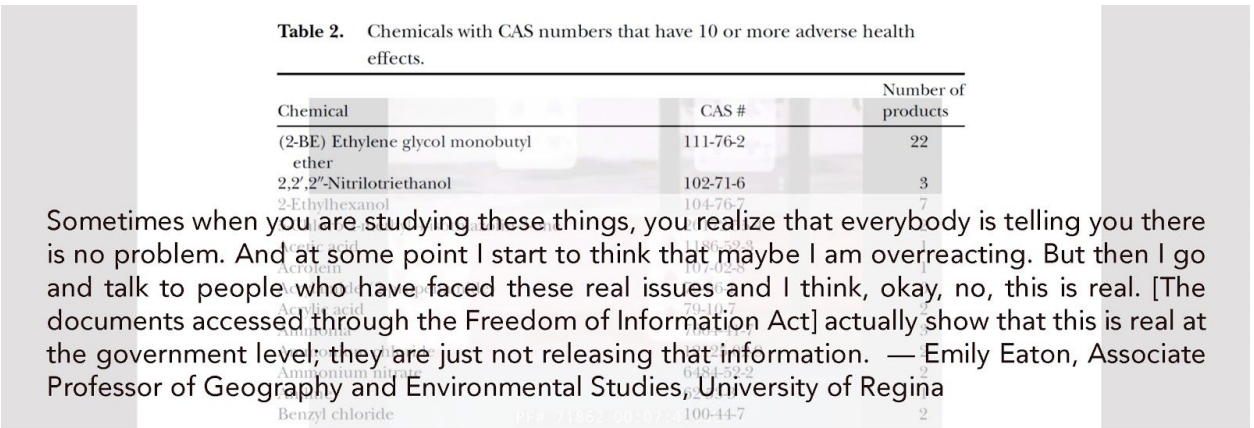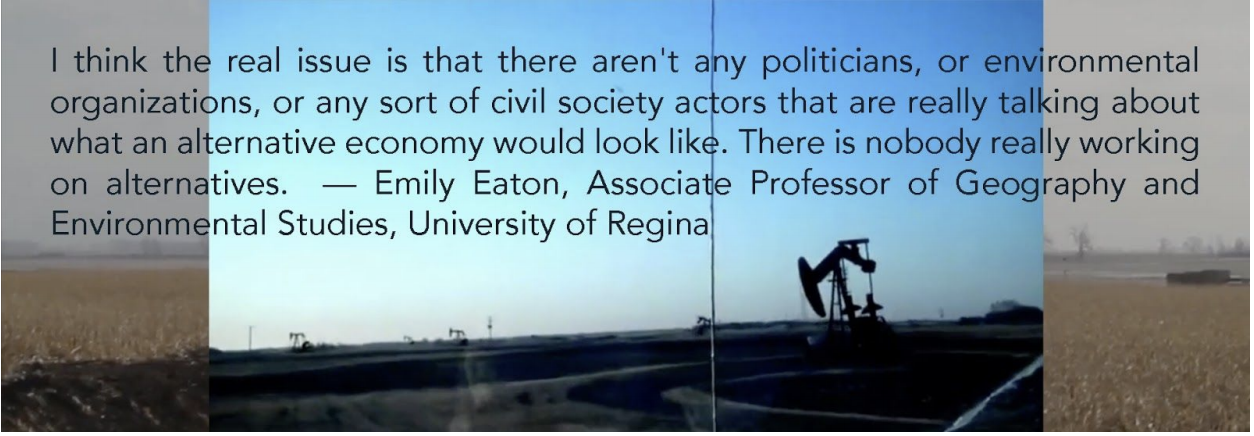By: Kristina Hedlund and Garance Malivel (Master of Environmental Studies, York University)

Last October, a media report was released by a collective of scholars, students and journalists under the name The Price of Oil. The report revealed that, for years, the Saskatchewan government had been withholding information about dangerous levels of sour gases emitted by the hydraulic fracturing industry in the southeastern corner of the province. In the wake of this report, we sought to further explore the health impacts and the regulation of the unconventional oil and gas industry (UOG) in the area. Though we were confronted by a lack of data, and a pervasive culture of silence around the issue, we were able to interview a PhD student who grew up in Estevan, an Associate Professor in Geography and Environmental Studies at the University of Regina, an Associate Professor in Sociology and Health Science at Northeastern University, a grain farmer from Southeast Saskatchewan, and a public health worker from the area. Their voices became the guiding thread for our research, which is briefly summarized here.
Hydraulic fracturing is an oil and gas extraction technique in which fluids, commonly consisting of water and chemicals, are combined with sand, and injected under high pressure to fracture underground rock formations. Since the 1980s, the combination of fracturing techniques and directional drilling has opened access to a large number of “unconventional” oil and gas deposits (shales, tight formations, and coalbed gas), that were inaccessible through conventional drilling and vertical wells. The southeast corner of Saskatchewan sits on top of a large part of the Bakken Formation, from which 1,4 million barrels of oil and 81.2 billion m3 of gas could potentially be extracted in the province. In 2016, the oil and gas industry employed approximately 32,000 people in Saskatchewan, and brought $600 million in revenue to the province, making it Canada’s second largest oil producer after Alberta.
The technological shifts towards UOG and its boom since the mid-2000s, has contributed to revitalizing the economy in certain rural areas, but has also increased the risks for public health and safety. In addition to anthropogenic earthquakes, and the large quantities of water used by the industry (an average of 1,5 million gallons per well in the U.S. between 2011 and 2013), over 1,084 chemicals have been identified in fracking fluids, many of which can persist as long-term contaminants. While hydrogen sulfide (H2S), a naturally occurring toxic gas that can be released during fracking operations, has been spotlighted in the media, it is but one of the hazardous substances associated with UOG. Other potentially harmful airborne chemicals include BTEX (Benzene, Toluene, Ethylbenzene, Xylene), Methane, Polycyclic Aromatic Hydrocarbons (PAH), Particulate Matters (PM), and Nitrogen Oxides (NOx). Instantly lethal above 1000 parts per million, H2S also presents a risk of pulmonary and neurological complications in lower concentrations. In the U.S. (where most of our data came from due to the dearth of study on the topic in Canada), recent analyses have focused on the neurodevelopmental and neurological effects associated with UOG contaminants in children, as well as on the increased risks of childhood leukemia in communities living close to unconventional oil fields. Several studies over the last decade have also raised concerns about the heavy metals that are circulated through produced water, and about the known endocrine disrupting chemicals contained in fracturing fluids—the composition of which Canadian companies are not required to disclose.
The persisting “uncertainty” reflected in public discourses around the health effects associated to UOG, owes to the fact that most studies have focused on short-term rather than long-term impacts of the related gases and chemicals, as well as to a politically fed willful ignorance that leaves these areas of research underfunded or ignored—a phenomenon researchers have started calling “undone science.” As underlined in the previously mentioned U.S. survey assessing the links between UOG and the risks of childhood leukemia, of the 143 identified air pollutants associated to UOG, 114 compounds, including H2S, have not been evaluated for carcinogenicity by the International Agency for Research on Cancer.

The increasing number of ailments reported by residents living near oil and gas facilities are often the reflection of poor regulatory practices. Saskatchewan, for instance, does not have an independent body enforcing the regulation of toxic emissions. They were until recently enforced by the Ministry of the Economy, which, in February 2018, was restructured into three new ministries. The Ministry of Energy and Resources now handles this regulatory work. A number of new facilities in Saskatchewan are exempt from environmental impact assessments, and the industries are trusted to self-declare their emissions. The reports released by The Price of Oil have also uncovered that in April 2014, documents about extremely high levels of H2S emissions had been circulated throughout the Ministry of the Economy, but no warnings were ever given to the affected communities. Shortly after, a worker died of H2S exposure. The following year, 43 oil and gas facilities were randomly tested in southeast Saskatchewan by the Ministry, and were found to be leaking H2S at an average concentration of 30,000 ppm.
At a national level, the Minister of the Environment and the Minister of Health jointly released a draft screening assessment in September 2017, which concluded that the current levels of H2S entering the environment are not a health concern for the general population, and that no further action needed to be taken to regulate emissions. However, the air concentration data used in the assessment was gathered 18 years ago, at a time when UOG was just beginning to expand in Canada.
In Saskatchewan, where the livelihood of many citizens still depends on the oil and gas industry, a majority of residents may understandably weigh the potential harms of toxic emissions against the positive health benefits associated with a larger income. Yet this narrative also creates fear among the residents about whether or not they should express their concerns. Those who do choose to speak out can face serious backlash, including criminal charges, social exclusion, and intimidation.
Craig Lothian, the president and CEO of the Regina-based Keystone Royalty Corp., referred to the media coverage on H2S incidents in Saskatchewan as “fake news,” and “shoddy research mixed with biased and unethical journalism.” Environmental NGOs also have an “alarming lack of knowledge and awareness about fracking activities in the area,” arguably because a number of their members are connected to the extractive companies. These attitudes, as well as the longstanding cultural and infrastructural prevalence of the oil industry in the province, contribute to the “nonmobilization” that muffles the concerns of the communities that are the most exposed to these health threats.

In addition to long-term policies that would foster the diversification of Saskatchewan’s economic sector, several measures applicable on the shorter term could initiate shifts towards better safety and sustainability in the province. The full disclosure of the chemicals used in the fracking processes should be considered a citizen’s right, and would enable further studies on their possible environmental and health impacts. Adequate and effective regulations should be enforced by an independent body, and could, for instance, include strict flaring limitations, and setback distances between wellbores and dwelling places. The example of other provinces and states has shown the usefulness of community mobilization to impact and improve regulatory practices. Participatory air monitoring initiatives, or community-based platforms such as the FracTracker Alliance in the U.S., can be inspiring and empowering tools to elicit the awareness and critical discussions that are essential for reclaiming rights to safe and healthy environments.

